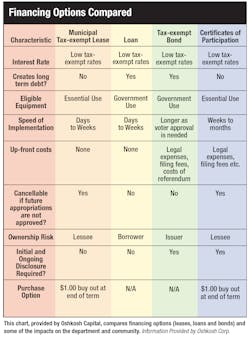Firefighters can spend months, even years, selecting the apparatus they want, the options that are necessary and even the color and logos. That’s fine when one considers that some apparatus can be in service for decades; however, proportionate effort needs to be given when considering the financial side of apparatus purchasing.
Plan the purchase
How to pay for an apparatus, when to purchase it, and the funding sources can all weigh heavily in the decisions a truck committee or a purchasing agent makes. “Funding is a critical issue,” says Phil Gerace, director of sales and marketing for KME Fire Apparatus. “… I don’t know that there’s a one-size-fits-all solution, but the important thing is to have a plan.”
There are myriad options and plans fire departments should consider when making financial decisions. The simplest plan is to save money and pay cash for apparatus when it’s time to make the purchase. Paying cash means municipalities save money that would usually go to interest and lease payments. Manufacturers sometimes offer discounts for cash transactions because they get their money quicker and cleanly.
Gerace says it’s important for communities to remember to time the arrival of their apparatus when the money is available. He points out municipalities will have to pay penalties on CDs if they have to withdraw money to pay for the apparatus that arrives months earlier than anticipated.
While some communities may have CDs and bank accounts laden with funds, many can’t come up with the money to pay for apparatus up front, especially with custom pumpers tipping the scale between $400,000 and $500,000 and aerials often exceeding $1 million. That leads communities to run apparatus far in excess of its lifespan. Apparatus purchases can be delayed for years while community leaders wrestle with whether to replace a dump truck for the highway department or make improvements to sidewalks with the need for a new fire truck.
Gerace recommends communities come up with a “structured apparatus replacement plan” that will allow fire departments to plan ahead and get trucks when they are needed—and when the funding is available. “We often see departments waiting until the trucks are ineffective and they have to make emergency purchases,” Gerace says. “That’s because they don’t have a coordinated replacement plan.”
Loan programs
When saving money for apparatus isn’t an option, some communities opt to borrow the money through a variety of loan programs, much like home or auto owners would do to make large purchases.
Fire departments can borrow money through local banks that are often willing to provide low-interest loans because they are part of the community and have a spirit and a willingness to serve the area in which they do business. There’s also another practical reason for banks and lending institutions to offer discounted loans: taxes.
Tom Whitmer, director of business development for Oshkosh Corporation, the parent company of Pierce Manufacturing, says most municipalities qualify for tax-exempt financing. “That’s when the customer doesn’t pay taxes, and the lender doesn’t pay any taxes on the loan,” Whitmer says, noting that communities can receive rates that are 65 percent of what businesses would pay in interest. “The reality is municipal customers are cheaper when it comes to taxes,” he says, adding that lenders can then pass that savings on to communities seeking loans.
While a loan, through bonding, is a good way to get the money communities need for apparatus, it does obligate the department to long-term debt and subject it to any penalties for default. “Default is a bad thing,” Whitmer says. “It can lead to litigation and all sorts of legal problems.” Default on municipal bond loans is rare, but it does happen, he says, pointing to Detroit as an example.
Bonds and loans can also accumulate as multiple projects and purchases are funded over years and affect communities’ debt limits, Whitmer points out.
There comes a time when communities hit debt ceilings and can borrow no more, which can limit future plans. It’s best to look at debt holistically when considering apparatus purchases and think about the highway department’s need to purchase a high-dollar road grader, for instance. That will keep communities from hitting that debt ceiling when critical purchases need to be made and there’s no way to borrow money to make the purchase.
Even with some of the limitations built into borrowing, municipal bonds are solid solutions for departments to get much-needed apparatus with affordable interest. It also frees communities from parting with hard-to-come-by cash when most are strapped for cash these days.
Lease-purchase options
A third consideration is lease-purchase options. Many manufacturers, especially the larger ones, offer this option, and there are a variety of third-party companies that will offer the same service, allowing communities to purchase virtually any apparatus they desire.
The lease-purchase option is a little more expensive than a municipal bond because of the risk involved for the lessors, but experts say it can still be cheaper than deferring purchases. That’s because the inflation rate is higher than the current lease interest rates.
Gerace says, like municipal bonding, municipal leasing is tax free and far less expensive than commercial leasing. “And with a lease, departments usually end up owning the apparatus,” he says. “Right now, the interest is less than inflation. So, departments that are waiting are actually loosing buying power.”
Whitmer agrees and says departments that defer apparatus purchases, rather than borrowing money or entering lease agreements, will probably spend more to purchase the same apparatus than if they bought it now and paid for it with some sort of financing. “The logic of leasing is you don’t have to come up with $500,000 today,” Whitmer says. “You have to come up with $78,000 over a seven-year term and then you’ll own the truck.” Depending on the lease agreement, some departments might have to come up with a “balloon payment” at the end of the agreement to purchase the apparatus.
Whitmer says that some manufacturers, like Pierce, offer a lease turn-in program where communities can pay for the use of the apparatus for a designated time, usually seven to 15 years, and have the option of letting the manufacturer take it back. Participating communities can usually expect to pay about 80 percent of the cost of the truck, he says.
“Flexibility in the fleet is the logic of a turn-in lease,” Whitmer says. “You can run the trucks and get out of them.” He adds that some communities that have low run numbers and keep their apparatus for 30 years in pristine condition might not realize much benefit out of such an agreement. However, the bigger communities that are tough on apparatus might realize significant savings and flexibility, he says.
Whitmer says the department that uses the lease turn-back option can avoid the “hockey stick of maintenance” when the cost of keeping the apparatus on the road goes from flat to virtually straight up on the ledger.
“At some point, the maintenance racks up on them,” Whitmer says, noting that some fire departments are very good at finding “the sweet spot” where apparatus have high resale values, and the community avoids steep maintenance costs.
One other benefit of lease agreements, Whitmer explains, is most don’t require a voter referendum to enter. They’re considered a cost of doing business and can be placed into operating budgets, he says, adding that a lease is not long-term debt and doesn’t require approval by voters.
Because of that, leases can often be executed quickly, and departments can have apparatus in service sooner with less cost. That’s because all the costs and time spent on voting preparation is avoided, Whitmer says. Also, it helps communities avoid the debt ceiling and keeps cash and borrowing power available for other needs, he adds.
Other options
Gerace says there are other important funding sources that shouldn’t be overlooked. Grants, for instance, can help any community make apparatus purchases, he says, adding that local, state and federal organizations have money earmarked for apparatus.
Communities should also look to developers constructing large residential or industrial projects for help funding apparatus, Gerace says. Many are willing to contribute to apparatus purchases to help protect the community and cover the costs of the growth they are generating, he says.
Additionally, casinos, petrochemical plants and other industries are ready and willing to provide funds for fire protection, Gerace says, noting that it’s worth exploring all avenues to come up with cash for apparatus.
The art of the purchase
“There’s a lot of art to it,” Whitmer says of apparatus financing. “Every department is different and every department is going to have different needs. Communities have options and they have to analyze them to figure out what’s best.”
About the Author

Ed Ballam
Ed Ballam served as associate editor for Firehouse. He is the assistant chief of the Haverhill Corner, N.H. Fire Department, and a National Registered EMT. He is also a Deputy Forest Fire Warden for the New Hampshire Division of Forests and Lands. Professionally, he's been a journalist for over 35 years working for a variety of publications, including employment as managing editor of a national fire service trade journal for more than a decade.
